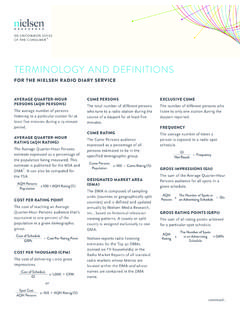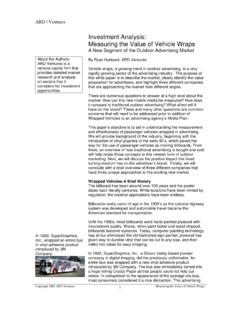Transcription of What’s wrong with aerosol cans? - US EPA
1 Best Environmental Practices for Auto Repair and Fleet Maintenance November 1999 Perceived problem 11 Refillable spray bottles require more labor time because they must be refilled. 22 Spray nozzles clog. 33 Refillable spray bottles are cumbersome. Real solution The time needed to refill a bottle (1 to 3 minutes) is comparable to the time needed to dispose of an aerosol can and obtain a new one. Clogs rarely occur, but when they do, they can usually be eliminated by blowing com pressed air through both sides of the spray nozzle. As a preven tative measure, technicians should clear spray nozzles with compressed air weekly, and keep dirt and grime out of the bottles when filling by using funnels with filters or screens.
2 Bottles the size of typical aerosol cans are available, and nozzle extensions can be attached to larger bottles. what s wrong with aerosol cans ? When compared to refillable spray bottles, they are expensive and have greater environmental consequences: Ounce for ounce, spray-on product sold in aerosol cans is roughly twice the cost of bulk product. You pay for propellants in every aerosol can you purchase. Most aerosol cans contain 10-15% propellant by weight. Carbon dioxide, propane, and butane are commonly used aerosol propellants. These are greenhouse gases that contribute to global warming and smog formation. Every year, individual auto repair and fleet maintenance facili ties discard hundreds, and sometimes thousands, of aerosol cans used to dispense brake cleaners, carburetor cleaners, lubricants and penetrants, engine degreasers, and numerous other products as trash, taking up valuable landfill space.
3 Used aerosol cans that are not empty may be considered hazardous waste by US EPA and many states. Shops and facilities that switch to refillable spray bottles are saving money by avoiding the high cost of aerosol cans and are helping to protect the environment by eliminating the solid and potentially hazardous waste stream they produce. This fact sheet is designed to help auto repair shop owners and fleet managers make informed decisions about implementing refillable spray bottles. what are refillable spray bottles? There are two basic types of refillable spray bottles: I) metal bottles that spray product using compressed air and 2) plastic bottles that use a hand pump to spray product.
4 Refillable metal bottles more closely resemble aerosol cans in terms of their design and performance. These bottles are filled with product (for example, brake cleaner) from a bulk container and are pressurized with air at 80 to 200 pounds per square inch using a compressed-air hose. Plastic bottles are also filled from bulk containers but do not require compressed air. Instead, they are operated by pumping a trigger to create a mist or stream of product. Refillable Spray Bottles what to consider when selecting refillable spray bottles Capacity. The capacity of air-pressurized, refillable spray bottles varies from 7 fluid ounces to 1 quart.
5 Smaller bottles are useful for spraying hard-to- reach areas. Larger bottles are more conve nient because they require less frequent filling and therefore less technician time. Construction material. Refillable spray bottles are available in different materials and with different finishes (aluminum, stainless-steel, brass, and steel) for use with different types of bulk product. Ask the spray bottle manufacturer whether the bottle is compatible with the product you intend to use. Nozzle type. l-quart, refillable spray bottles come with standard spray and stream nozzles. A nozzle that can be adjusted from stream to spray is also available.
6 Smaller bottles (16- and 8-fluid ounce) are available that closely resemble the size and shape of aerosol cans and have a spray pattern similar to an aerosol can spray. Nozzle extensions. Nozzle extensions up to 12 inches long are available for spraying areas that are otherwise difficult or impossible to reach . Cost. Air-pressurized, refillable spray bottles cost from $25 to $60 each, depending on the construction material. Chemically resistant plastic bottles and hand pumps cost from $1 to $6 each. Be sure to check with the product vendor about plastics that are compatible with their chemical product. Recycle used aerosol cans Under the federal Resource Conservation and Recovery Act (RCRA), aerosol cans may be recycled if they have been emptied through normal use or punctured and drained to remove significant liquids.
7 Some states such as California have more stringent regula tions than RCRA. Be sure to investigate state regulations before recycling aerosol cans . Shops are responsible for properly managing any captured wastes recovered from puncturing and draining. Economy. Ounce for ounce, bulk product is cheaper than aerosol cans . Most common spray-on products are available in containers ranging in size from 1 to 55 gallons. You may be able to obtain free refillable spray bottles from your vendor when you purchase their product. Maximizing benefits Refillable spray bottles do work and can reduce costs-if they are used correctly.
8 Therefore, be sure to: Avoid product losses due to spills during refilling. Use funnels and pumps to minimize spills (see next page for details). Keep replacement parts on hand. Small, inexpensive parts such as nozzle seals, filler caps, valves, and nozzles may deteriorate with repeated use and pressurization. Refillable spray bottles will be used if they are as convenient for workers as aerosol cans ; therefore, provide every technician with a refillable spray bottle for each type of frequently used aerosol product. Water in the shop air lines may cause corrosion in some steel refill able spray bottles. Ensure that your shop air supply has a water removal device.
9 Best Environmental Practices for Auto Repair and Fleet Maintenance Case studies: Cost-effective aerosol can reduction Three auto repair shops (Nielsen Automotive in San Carlos, CA; Glenmoor Auto Repair in Fremont, CA; and Salem Boys Auto in Tempe, AZ) and one fleet maintenance facility (City of Sunnyvale, CA) contributed information regarding their use of pressurized, refillable spray bottles. This information is summarized below. Very few implementation problems occurred at the shops. One shop had problems with minor spills during bottle refilling. To prevent such spills, the shop modified a $ hand pump to fit a l-gallon bulk product container.
10 While the pump eliminated spills; it increased the refilling time from about 1 minute to 3 minutes per bottle. Another shop also had a nozzle clog, which was corrected by blowing compressed air through both sides of the nozzle. Shop owners and fleet managers noted the following refillable spray bottle advantages: Cost Savings. We reduced our aerosol product costs by 84 percent for the same brake cleaner by switching to refillable spray bottles and eliminating aerosol can disposal costs. Efficiency. Technician efficiency is improved! A technician requires about 1 minute to refill and pressurize a spray bottle, which is much less time than it took to walk to the storeroom to get a new aerosol can.















